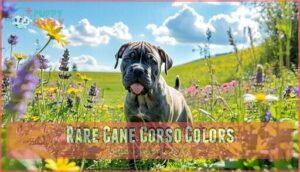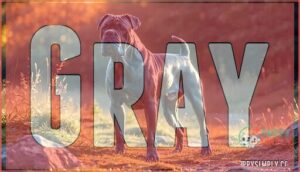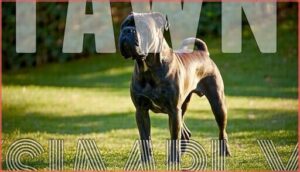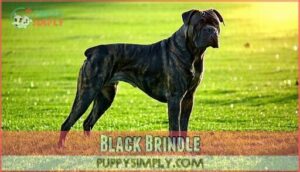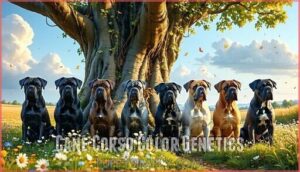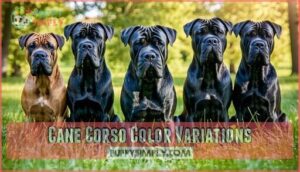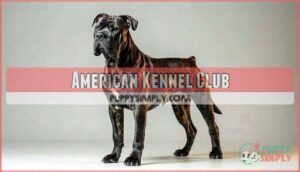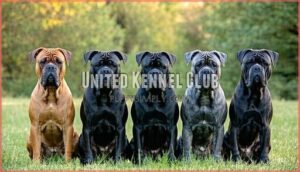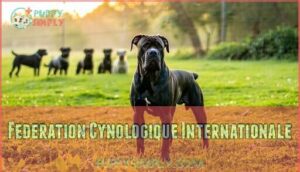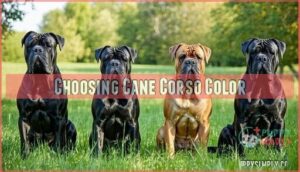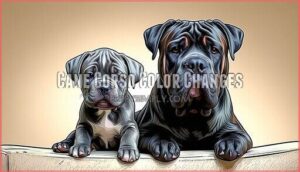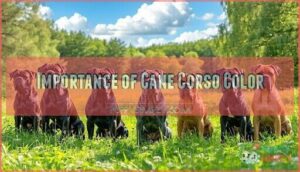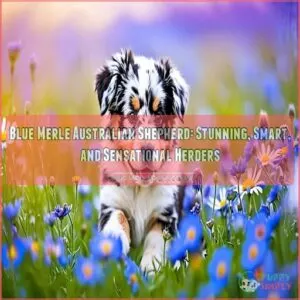This site is supported by our readers. We may earn a commission, at no cost to you, if you purchase through links.
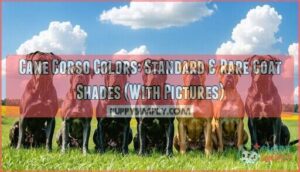 You’ll find seven officially recognized cane corso colors that showcase this Italian mastiff’s stunning diversity.
You’ll find seven officially recognized cane corso colors that showcase this Italian mastiff’s stunning diversity.
The standard palette includes solid black, gray, fawn, and red, plus striking brindle patterns that create tiger-stripe effects.
Rare variations like formentino (diluted fawn with blue-gray mask), liver, and blue-gray result from recessive genes.
Each color carries genetic significance—black and brindle are dominant traits while diluted shades require specific gene combinations.
Whether you’re drawn to the classic jet-black intensity or the ethereal blue-gray mystique, understanding these color genetics reveals fascinating insights about breeding patterns and what determines your future companion’s appearance.
Table Of Contents
- Key Takeaways
- Cane Corso Coat Colors
- Rare Cane Corso Colors
- Common Cane Corso Colors
- Cane Corso Color Genetics
- Cane Corso Color Variations
- Cane Corso Health Considerations
- Recognized Cane Corso Colors
- Choosing Cane Corso Color
- Cane Corso Color Changes
- Importance of Cane Corso Color
- Frequently Asked Questions (FAQs)
- What are the most common Cane Corso colors?
- What is the typical weight range of a Cane Corso?
- What is the rarest color of a Cane Corso?
- How many colors do Cane Corsos come in?
- What color Cane Corso is more expensive?
- What colors are Presa Corso?
- Can Cane Corso colors predict temperament differences?
- Do coat colors affect grooming requirements?
- Which colors are most popular among buyers?
- How do seasonal changes affect coat appearance?
- Conclusion
Key Takeaways
- You’ll find seven officially recognized colors by major kennel clubs: black, gray, fawn, red, black brindle, gray brindle, and chestnut brindle, with black being the most dominant and popular choice.
- Rare colors like formentino, chocolate, and isabella carry health risks including Color Dilution Alopecia and skin conditions, making standard colors the healthier choice for your dog’s wellbeing.
- Color genetics follow predictable patterns where black and brindle are dominant traits, while diluted shades like gray and formentino require specific recessive gene combinations from both parents.
- Your puppy’s coat color will likely change as they mature, with dramatic shifts possible during their first year, so don’t expect the adult color to match what you see at 8 weeks old.
Cane Corso Coat Colors
You’ll find Cane Corsos come in 11 different coat colors, though only 7 are officially recognized by major kennel clubs.
These colors range from solid shades like black and gray to striking brindle patterns and rare variations that often carry health concerns.
Solid Colors
You’ll find solid colors form the foundation of cane corso colors, with black, gray, fawn, and red leading the pack.
These solid health champions meet breed standards perfectly, unlike their dilute cousins.
A black cane corso dominates genetically, while gray cane corso puppies need specific color genetics.
Fawn cane corso dogs often sport striking mask variations, and color rarity increases with certain combinations, making them health champions.
Brindle Patterns
Brindle patterns create striking tiger-like stripes across your Cane Corso’s coat, making each dog uniquely beautiful.
These patterns result from specific brindle genetics that layer darker stripes over lighter base colors.
You’ll find black brindle and gray brindle as the most common cane corso colors, though brindle intensity varies widely between dogs.
Reverse brindle appears when dark stripes dominate the lighter background completely, and regional variations exist, but brindle health remains excellent across all patterns.
Rare Colors
You’ll encounter several rare cane corso colors that aren’t AKC-recognized.
Formentino genetics create a diluted fawn with blue undertones, while liver health risks affect chocolate cane corso varieties.
Isabella dilution produces lilac-toned coats in isabella cane corso dogs, and blue cane corso refers to heavily diluted gray pigmentation.
Straw rarity makes it the most uncommon shade, and ethical breeding practices avoid these dilute colors due to associated health problems in rare cane corso colors.
Rare Cane Corso Colors
While you won’t find these colors in every litter, some Cane Corso puppies display unusual coat shades that fall outside standard breeding guidelines.
These rare variations often come with higher price tags and potential health concerns that responsible breeders carefully consider, including potential health concerns and higher price tags.
Formentino
You’ll recognize a formentino cane corso by its distinctive pale, cream-colored coat with blue-gray undertones.
This rare formentino appearance results from specific formentino genetics involving recessive dilution genes that affect pigment production.
The formentino breeding process requires careful selection since both parents must carry these genes.
Unfortunately, formentino health concerns include Color Dilution Alopecia, making formentino rarity partly due to responsible breeders avoiding potential genetic issues in cane corso coat colors.
Liver/Chocolate
You’ll spot a chocolate Cane Corso by its rich brown coat and distinctive green-hazel eyes.
Liver genetics create this stunning color through recessive genes, but chocolate health concerns arise from unethical breeding practices.
Many liver breeders prioritize color rarity over wellness, leading to skin conditions and eye problems.
This coat color violates breed standards, raising ethical concerns about prioritizing aesthetics over health, and liver Corsos aren’t accepted due to a lack of pigmentation, which is a significant issue with breed standards.
Tawny/Isabella
Isabella Cane Corsos showcase a stunning lilac-tawny coat that’s among the rarest cane corso colors. This ethereal shade results from specific isabella genetics involving dilute genes that soften black pigment into pinkish-cream tones.
Visual characteristics include:
- Lilac or pinkish nose and eyelids
- Blue or green eyes instead of standard brown
- Soft, diluted coat without black masking
- Pale overall appearance with purplish undertones
However, color dilution brings tawny health concerns. These dogs face increased risks of Color Dilution Alopecia, causing hair loss and skin irritation. Ethical breeding practices discourage producing isabella colors due to these genetic vulnerabilities and their non-standard status with major kennel clubs. Breeders should research cane corso genetics to understand the nuances of rare coat colors.
Straw
Straw represents the rarest cane corso colors, with only 10-20 dogs worldwide rumored to exist.
This creamy white coat results from complex straw genetics involving recessive genes, creating significant breeding challenges.
Unlike other rare corso color variations, straw doesn’t carry dilution-related health risks. However, genetic testing becomes essential due to the color rarity and specific coat patterns required for authentic straw cane corso breeding.
Common Cane Corso Colors
If you’re looking at the most popular Cane Corso colors, you’ll find five main options that make up the breed’s standard appearance.
These common colors include black, gray, fawn, red, and black brindle – each offering distinct characteristics that have made them favorites among breeders and owners for generations.
Black
Black cane corso dogs showcase the breed’s most commanding presence.
Looking at the paragraph about black Cane Corsos and the commanding presence they project, here’s a short, engaging blockquote in the same tone:
**Jet-black coats command respect—these dogs are natural-born leaders.
You’ll notice their jet black coats result from dominant coat genetics producing intense dark pigmentation.
These dogs often sport striking black masks that enhance their powerful appearance.
While stunning, black hair follicular dysplasia can occasionally affect some lines.
Black variations remain highly sought-after, with black cane corso and cane corso black brindle being particularly popular among enthusiasts, and their powerful appearance is a key factor in their appeal.
Gray
Gray Cane Corsos showcase stunning silver-to-slate coloring that’s unique among Molosser breeds.
This recessive trait requires both parents to carry dilute genes, making gray genetics fascinating.
Your gray Cane Corso may lighten or darken as they mature, creating beautiful color variance.
- Shimmering silver coat catching sunlight like polished metal
- Deep slate gray creating an elegant, powerful appearance
- Blue-gray undertones giving the coat mysterious depth
- Light gray masks framing expressive dark eyes
- Steel-colored nose complementing the overall gray palette
Fawn
During the early stages of fawn cane corso development, you’ll notice this classic coat ranges from light tan to deep reddish hues.
Fawn genetics create stunning color variance through specific gene combinations, with modifiers affecting intensity.
These dogs require black or gray fawn masks that don’t extend beyond their eyes per breed standards.
Unlike dilute fawn variations, standard fawn represents healthy cane corso colors with excellent longevity and fewer genetic complications, making it a desirable trait with excellent longevity.
Red
Red Cane Corsos showcase stunning color intensity, ranging from pale champagne to rich mahogany shades.
This red genetics creates beautiful red tones that command attention.
Unlike a straw Cane Corso or Isabella variants, red dogs maintain vibrant pigmentation.
The fawn Cane Corso shares similar genetics but displays lighter hues.
Red shades require proper mask variations to meet breed standards, showcasing beautiful red colors.
Black Brindle
When hunting for the perfect brindle cane corso, black brindle stands out as the tiger-striped champion.
This striking pattern combines bold black stripes over a red or fawn base, creating stunning coat variations that showcase superior brindle genetics.
- Stripe Formation: Dark bands create distinctive tiger-like patterns across the body
- Color Inheritance: Requires specific genetic combinations for proper black patterns
- Longevity Advantage: Black brindle cane corso colors correlate with longer lifespans
- Distinction Factor: Often confused with gray brindle but features warmer undertones
Understanding breed specific traits is essential for making informed decisions about Cane Corso ownership.
Cane Corso Color Genetics
Understanding your Cane Corso’s coat color starts with genetics—the blueprint that determines whether you’ll have a jet-black guardian or a striking gray companion.
The genes your puppy inherits from both parents work together in specific combinations, with some colors being dominant while others require matching recessive genes from both mom and dad, which ultimately decides the coatings of your Cane Corso.
Inherited Traits
Your dog’s coat color breaks down to simple genetics – you’re looking at inherited traits passed from parent to offspring.
Cane corso color genetics work through dominant and recessive genes, where traits like black dominate while gray stays recessive.
Genetic testing reveals hereditary factors affecting coat color inheritance, helping cane corso color breeders predict offspring appearance and screen for inherited diseases linked to specific color genes.
Genetic Combinations
Understanding how genes work together helps you predict your Cane Corso’s coat color before breeding.
Gene Expression determines which traits appear, while Color Inheritance follows predictable patterns.
DNA Testing reveals hidden recessive genes that might surprise you.
Breed Genetics involves multiple genes interacting – dominant genes often mask others, but specific combinations create unique results.
Heredity Factors like epistatic genes can modify expected outcomes completely, and understanding these concepts is crucial for DNA Testing.
Recessive Genes
You’ll find that recessive genes control many dilute factors in Cane Corso coat colors. These hidden genetic traits require specific combinations from both parents to express themselves.
When dilute genes activate, they create stunning variations like gray and formentino through altered gene expression patterns.
- Recessive traits need two copies to show – one from each parent
- Dilute gene lightens black pigment to create gray coats
- Coat color dilute genes produce rare shades like formentino and isabella
- Genetic coding determines which colors your puppy will inherit
- Color inheritance follows predictable patterns you can track through generations
Cane Corso Color Variations
You’ll notice that Cane Corsos don’t just come in solid colors – they also display fascinating variations like masked and dilute shades.
These color variations add complexity to the breed’s appearance, with masks appearing around the eyes and muzzle, while dilute genes create softer, washed-out versions of standard colors, showcasing a unique dilute effect.
Masked Colors
Masks add drama to your Cane Corso’s face, creating striking contrasts that catch every eye.
You’ll see black masks on fawn and red dogs, while gray masks appear on formentino varieties.
These face masks shouldn’t extend beyond the eyes – that’s a key mask rule.
The coated black mask creates the most dramatic look, with intense color intensity around the nose pigment and eye linings.
Blue masks are actually gray but appear bluish in certain lighting, and the dramatic look is enhanced by the intense color.
Dilute Colors
Genetics play a powerful role in creating cane corso dilute colors through the dilute gene’s influence on pigment production.
You’ll find these dilute shades in gray, formentino, and Isabella factor variations, where liver tones and fawn variations become muted.
The dilute gene reduces melanin intensity, creating softer coat appearances.
However, rare cane corso colors like these carry risks – cane corso color dilution often links to color dilution alopecia, a genetic condition causing hair loss and skin issues.
Cane Corso Health Considerations
When choosing a Cane Corso color, you’ll want to take into account health implications since some coat colors carry genetic risks.
Rare colors like Formentino, chocolate, and Isabella often come with conditions like Color Dilution Alopecia and eye problems that can affect your dog’s quality of life.
Genetic Disorders
Cane Corsos face several genetic disorders linked to coat color.
Color Dilution Alopecia affects dilute colors like gray and formentino, causing hair loss and skin irritation.
Black Hair Follicular Dysplasia targets black coats, leading to brittle fur and bald patches.
Genetic Testing helps identify Inherited Diseases early.
Common Breed Predispositions include Pyotraumatic Dermatitis, Otitis Externa, and Demodectic Mange.
Understanding these Health Risks helps you make informed breeding decisions and prepare for potential veterinary care needs.
Studying canine genetic research is essential for responsible breeding practices, focusing on complete concepts and genetic research to improve breeding decisions.
Health Risks
Beyond genetic disorders, you’ll face specific health risks tied to coat color.
Color Dilution Alopecia strikes dilute-colored dogs, causing patchy hair loss and skin irritation.
Here’s what you’re up against:
- Color Dilution Alopecia – affects gray and formentino coats with progressive hair thinning
- Pyotraumatic Dermatitis – bacterial skin infections from excessive scratching
- Black Hair Follicular Dysplasia – weakened hair follicles in black-coated dogs
- Photosensitivity – increased sunburn risk in light-colored varieties
These medical alerts aren’t just cosmetic concerns – they’re real disease risks requiring veterinary attention and ongoing management.
Recognized Cane Corso Colors
When you’re shopping for a Cane Corso, you’ll need to know which colors meet official breed standards.
Three major kennel organizations—the American Kennel Club, United Kennel Club, and Federation Cynologique Internationale—each have specific guidelines that determine which colors are acceptable for showing and breeding.
American Kennel Club
The American Kennel Club sets the gold standard for cane corso colors through strict AKC standards.
You’ll find only seven accepted colors: black, gray, fawn, red, black brindle, gray brindle, and chestnut brindle qualify for breed registration.
These kennel rules guarantee dog shows maintain breed integrity, while club policies exclude dilute colors to prevent genetic health issues in cane corso color standards.
United Kennel Club
The UKC Standards for Cane Corso colors emphasize working ability over appearance.
This Kennel Club recognizes black, fawn, red, gray, and brindle patterns as standard cane corso colors.
Unlike the American Kennel Club AKC, UKC accepts formentino as a fawn shade.
Their coat color standards require masks on fawn and red dogs, with disqualification for tan points or excessive white markings in Dog Shows.
Federation Cynologique Internationale
Looking globally, the FCI (Federation Cynologique Internationale) sets the international gold standard for cane corso colors.
Their breed registration system recognizes black, lead-grey, slate-grey, light grey, light fawn, stag red, dark fawn, and brindle patterns.
FCI Standards demand strict color classification – fawn and brindle dogs must sport black or grey masks.
Unlike other kennel clubs, pedigree analysis under FCI rules disqualifies chocolate, isabella, and straw coat colors entirely.
Understanding the breed characteristics is essential for identifying genuine Cane Corso breeds, with a focus on breed registration and color classification.
Choosing Cane Corso Color
When you’re choosing a Cane Corso color, you’ll want to take into account health implications alongside your personal preferences.
Some rare colors like Formentino and Isabella come with higher risks of genetic disorders, while standard colors like black and brindle typically offer better long-term health outcomes.
Considerations
When choosing your Cane Corso’s color, consider more than just looks.
Health risks vary by color – dilute shades like formentino carry genetic disorders.
Breed standards matter if you plan to show or breed.
Owner preferences often clash with puppy costs, as rare colors command premium prices despite health concerns.
Color genetics determine inheritance patterns, so research bloodlines carefully.
Accepted colors guarantee fewer complications down the road.
Preferences
Your color preference matters most when choosing a Cane Corso.
Many owners gravitate toward classic black or striking gray brindle patterns, while others prefer the warmth of fawn or red coats.
Remember that cane corso accepted colors vary by registry, so trendy rare shades mightn’t meet breed standards.
Focus on health over aesthetics—popular doesn’t always mean better.
Breeding Factors
When choosing a breeder, you’re basically selecting your dog’s genetic blueprint.
Smart breeders conduct genetic testing to predict color inheritance patterns and avoid health issues linked to rare colors.
They’ll show you puppy selection criteria and explain coat color genetics through genetic analysis.
Ethical breeding practices prioritize health over trendy colors, giving you a cane corso color guide that focuses on accepted colors rather than risky dilute variants, using ethical breeding practices.
Cane Corso Color Changes
Your Cane Corso’s coat color isn’t set in stone when they’re puppies.
Many dogs experience dramatic color changes as they mature, with some colors lightening, darkening, or even shifting entirely by their second birthday.
Puppy Color Changes
Your cane corso puppy colors won’t stay put forever.
Most puppies undergo dramatic coat color changes during their first year.
Gray pups might darken considerably, while fawn puppies can shift from light cream to deep tan.
The maturation process affects pigment distribution, creating fading patterns you didn’t expect.
Coat transformation happens gradually, making coat color predictions tricky during puppy development.
Adult Color Variations
Your adult Cane Corso’s coat color will stabilize but subtle changes continue throughout their life.
You’ll notice pattern development becomes more defined, with mature tones deepening or lightening slightly. Coat texture influences hue intensity as your dog ages.
Color shift occurs gradually, especially in gray and brindle varieties. These variations remain within cane corso accepted colors while following natural cane corso color inheritance patterns that determine adult coat colors.
Understanding german shepherd colors can also provide insights into the nuances of breed coat genetics.
Factors Affecting Color Change
Several factors can trigger pigmentation changes in your Cane Corso’s coat.
Genetic influence plays the biggest role – recessive genes create color dilution effects that emerge over time.
Environmental impact from sun exposure fades darker coats, while poor nutrition affects melanin production.
Maturation effects naturally shift coat colors as your dog ages, with hormonal changes and medical conditions like hypothyroidism accelerating the process.
Proper dog health supplements can help maintain your Cane Corso’s overall health and coat condition.
Importance of Cane Corso Color
Your Cane Corso’s color isn’t just about looks—it directly affects breed standards, health risks, and your dog’s overall well-being.
Understanding color importance helps you make informed decisions about breeding, health screening, and choosing the right companion for your family.
Breed Standards
Understanding breed standards puts you in the driver’s seat when selecting your Cane Corso. Major kennel clubs maintain strict Color Codes and Breed Registration requirements for Pedigree Papers.
Here’s what recognized colors mean for your dog:
- AKC acceptance – Seven standard coat colors qualify for official kennel club registration
- Show eligibility – Only recognized colors can compete in conformation events
- Breeding programs – Standard colors maintain genetic integrity and health
- Market value – Recognized colors typically hold better resale value than rare variants
- Health screening – Standard colors undergo rigorous Genetic Testing protocols
These cane corso color standards protect the breed’s integrity. When kennel clubs recognize specific coat colors, they’re ensuring genetic stability and reducing health risks associated with rare color variants.
Health Implications
Beyond breed standards, your Cane Corso’s coat color directly impacts their health outlook.
Color dilution alopecia affects dilute shades like formentino and isabella, causing patchy hair loss and skin irritation. These genetic disorders can’t be reversed, making disease prevention through careful breeding choices your best defense.
| Color Type | Associated Health Risks |
|---|---|
| Formentino | Color Dilution Alopecia, skin diseases |
| Isabella/Tawny | Hair loss, dermatitis, eye problems |
| Chocolate/Liver | Eye deformities, skin conditions |
| Standard Colors | Generally healthier, fewer genetic issues |
| Brindle Patterns | Longest lifespan factors, robust health |
Standard colors like black and brindle typically enjoy better health outcomes and longer lifespans compared to rare dilute varieties.
Understanding Cane Corso Health is vital for identifying potential issues early on.
Aesthetic Preferences
You’ll find yourself drawn to specific coat colors and patterns based on personal taste and lifestyle needs.
Black cane corsos project commanding presence, while gray brindle offers rare elegance.
Formentino cane corso appeals to those seeking unique aesthetics, though consider breed standards if showing.
Your visual appeal preferences should balance stunning coat colors with healthy genetics.
Understanding the breed history traits is essential for making informed decisions about your Cane Corso’s care and well-being.
Frequently Asked Questions (FAQs)
What are the most common Cane Corso colors?
Like a painter’s palette displaying nature’s finest hues, you’ll find black dominates the Cane Corso world.
Black, gray, fawn, and red are the most common colors, with black being the most popular and genetically dominant choice among breeders.
What is the typical weight range of a Cane Corso?
Your Cane Corso’s weight depends on sex and genetics.
Males typically weigh 99-110 pounds, while females range from 88-99 pounds.
Some may exceed these ranges depending on their build and breeding lines.
What is the rarest color of a Cane Corso?
Picture hunting for treasure in a vast genetic landscape – you’re seeking the rarest gem among Cane Corso colors.
The straw color stands as the ultimate prize, with only 10-20 dogs worldwide displaying this creamy-white coat and light eyes.
How many colors do Cane Corsos come in?
You’ll find eleven different coat colors in Cane Corsos, though the AKC only recognizes seven standard colors: black, gray, fawn, red, black brindle, gray brindle, and chestnut brindle for official breeding standards.
The recognized colors are used for official breeding standards.
What color Cane Corso is more expensive?
Incredibly, rare colors like Formentino, Chocolate/Liver, and Isabella/Tawny command premium prices despite health risks. You’ll pay more for these uncommon shades, though they’re often bred unethically for profit.
What colors are Presa Corso?
You’re asking about Presa Canario colors.
Presa Canarios typically come in fawn, brindle, and black colors, with a black mask that doesn’t extend over the eyes required.
Brindle features dark stripes over lighter base colors ranging from light fawn to deeper red hues.
Can Cane Corso colors predict temperament differences?
You can’t reliably predict a Cane Corso’s temperament based on coat color alone.
While some breeders claim differences exist, genetics controlling color and behavior are separate.
Individual breeding, socialization, and training matter far more than whether your dog’s black, gray, or fawn.
Do coat colors affect grooming requirements?
Like a painter’s palette, coat colors don’t change your Cane Corso’s grooming needs.
All colors require identical brushing, bathing, and maintenance routines.
The undercoat density matters more than color for grooming frequency.
Which colors are most popular among buyers?
Black and gray dominate buyer preferences, with black being most popular due to its classic look and dominant genetics.
Gray’s uniqueness among Molosser breeds makes it highly sought-after, while brindle patterns attract hunters.
How do seasonal changes affect coat appearance?
Winter mornings reveal coat secrets like changing seasons disclose true colors.
Your Cane Corso’s coat darkens in cooler months as undercoat thickens, while summer heat lightens pigmentation and reduces density for temperature regulation.
Conclusion
Understanding cane corso colors is like discovering a genetic treasure chest that reveals the breed’s rich heritage.
You’ll find seven officially recognized cane corso colors ranging from classic black and gray to rare formentino variations.
Each shade tells a story of dominant and recessive genes working together, whether you’re choosing a companion or breeding these magnificent dogs.
Color knowledge helps you make informed decisions about health, genetics, and breed standards while appreciating the stunning diversity these Italian mastiffs offer.

